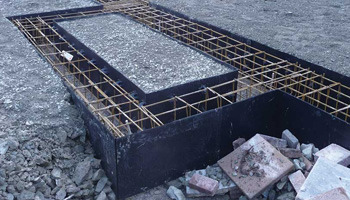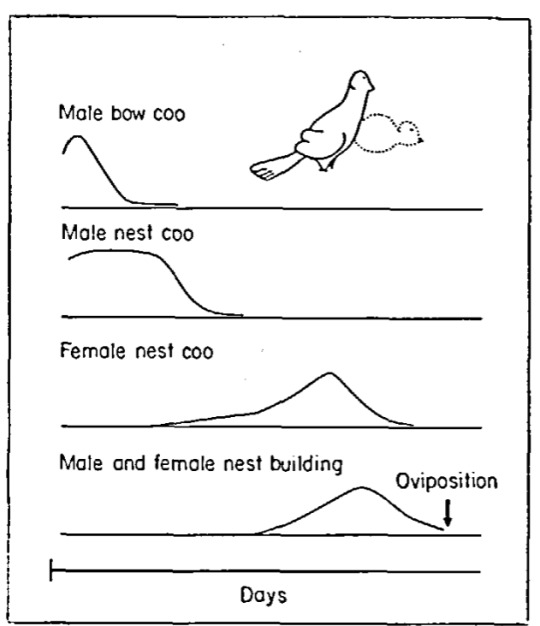#Basic components of a building and functions of these components are necessary to be
Explore tagged Tumblr posts
Text

Components of Building and their Functions -BuildersMART
www.buildersmart.in
#foundation#floors#walls#beams#columns#roof#stair#Basic components of a building and functions of these components are necessary to be#well-known before constructing a house. Know more about Building Components and their functions in this blog post.
1 note
·
View note
Note
I'm sorry? Pigeons have to coo to ovulate?
okay, okay, I left this one out in the tags without elaborating the other day and you were not the only person who asked-- @nanavn and @corvus--caurinus were also curious. I did not have a ton of time yesterday when my brain was not leaking out my ears, so here I am today.
First, I apparently misremembered my grad school teachings: the best-documented case study of doves being required to hear their own coo in order to ovulate is that of the ring or Barbary dove (Streptopelia risoria), not the rock dove which gave rise to our domestic pigeons (Columba livia). They look like this:

They're the domestic doves you see sometimes that aren't domestic pigeons.
But yes, I was completely serious: hens need to very specifically hear their own nest coo to ovulate. The way it works is this: these doves have a very specific courtship pattern, where courting males at different stages of the nesting process perform first a "bow" coo, then a nest coo. Then the hen makes a nest coo back, and the pair goes on to build a nest together in which the hen will lay fertile eggs.

If you prevent the hen from producing this coo--and the first paper I've linked does this in several different ways with both neural lesions and also mechanical blocks of the synrinx--she will not ovulate. Then Dr. Cheng tried rescuing the effect for doves who could hear but not produce their own coos by playing back recordings of devocalized doves' own nest coos, recordings of other hen's nest coos, recordings of male nest coos (their own males, I think, for preference?) and no recordings at all. Hen nest coo recordings, especially the recordings of the hens themselves, were enough to rescue ovulation effect... but deafened hens who could, themselves produce nest coos weren't able to make ovulation happen half the time even when the male was right there. The male nest coo and his mating display is really important, because his coo stimulates the female to make her nest coo, and that's where ovulation starts.
In 2003, a little over a decade later, Dr. Cheng wrote a whole book chapter about auditory self-stimulation as a phenomenon in neuroendocrine shifts. It makes for pretty interesting reading! I'm going to really enjoy it this afternoon. Stimulated ovulation is actually a pretty common phenomenon in animals--often it makes more sense to only bother ovulating if you know there's a partner around to use whatever eggs you yield up--but this one is one of the most interesting and elaborate systems out there, and definitely the one that offers the most options to a given female dove to potentially consciously control her reproductive output.
But grison, you might ask, what about the doves outside my window? Is this just a function of this one dove species, or are lots of doves doing this to make ovulation happen? So I went looking to find out whether anyone has checked. The thing is that the heyday of pigeon behavioral research has faded somewhat in the intervening decades since Dr. Cheng's discovery, so there's not as much as I might hope where people sat down to investigate the question. I did, however, find a neat study on Columba livia demonstrating that auditory stimulation is more important to courtship displays and success than visual displays are, although of course the multisensory courtship is stronger than either sensory modality alone. So yeah, the cooing back and forth really loudly is part of a display that is functionally necessary for successfully producing offspring, and the auditory component is important for basically every pigeon that has been studied in this respect (albeit that number is pitifully small).
I also found this really interesting review of known uses of birdsong to set internal emotional states in birds (either for the self or for a partner or flockmates) that I want to look into with more detail, plus this really thoughtful review from Dr. Donna Maney talking about how "incentive salience" can use learning and experience to make certain cues bring up neuroendocrine changes in state over time, which helps individuals control how their endocrine system is reacting to stimuli in the world they've been shaped by. Clearly I have some reading to do...
467 notes
·
View notes
Text
20dollarlolita pattern school step 3) prep and pattern selection.
NOTE: Here's a link to the pattern school discord. If this link has expired, please message me off-anon and I can send you one. I like to get to know everyone in the pattern school and so I don't let too many people in at once, so that I don't get overwhelmed.
So quick summary of where we were: Pattern School is a project that I'm working on in this blog, and that has an accompanying Discord server. The purpose of Pattern School is to teach people, though hands-on experience, the consistent conventions that sewing patterns use. It also teaches basics about how to transform patterns into designs that do what you want them to do. Pattern School is divided up into steps. Each step builds on the skills of the previous one, and each one teaches new elements.
Here's the pattern school tag, in chronological order.
In step 1, everyone follows a commercial pattern with notches, grainlines, and written instructions. This pattern is for something that is not fitted to a human body/is not multi-sized. In this step, we make sure that everyone has a basic foundation understanding of how commercial patterns are made. We choose a non-fitted item so that selecting the correct fit and adjusting for body shape is not necessary. If the student wishes, an additional challenge for step 1 will be to look at a pattern, see if it's usable in lolita fashion, and make good fabric and trim selections to make a usable lolita item.
In step 2, we take a pattern for pajama pants and use it to create bloomers. This step introduces the basics of pattern manipulation. We go into how to remove seam allowance, measure ourselves for fullness, and assemble a garment from a modified pattern. Once again, there is a challenge of choosing good trim and fabric options to build a usable lolita garment.
In step 3, we will be making a lolita or lolita-adjacent garment for ourselves. This garment will be a fitted item, and it will have a closure. What's a closure? Closures are something that opens and closes to allow the wearer to get in and out of the garment. Closures can be zippers, button plackets, hooks and eyes, IDK freaking magnets or something, if you want to put velcro as a closure then more power to ya, but your garment needs to have some kind of closure. I've made resources for how to put in zippers, but other closures are probably also acceptable. Pullover elastic is not a closure. We are making a garment for ourselves because it's a lot easier to make a fitted garment when you have the body you're using right there with you at all times. If you are always with another human being while you sew, you could probably use them, but the critical component is that you have the body accessible to you all the time.
This time, the challenge is also to make something that either can be part of your lolita wardrobe, or that forces you to choose and style something that has a lot of lolita fashion aesthetics. If you want to pick a lolita-adjacent concept, like Aristocrat or Fairy Kei, you're probably fine? If you're doing this on your own, the person who decides if you're cheating is you. If you're in the Discord, you can ask if something's acceptable and like 15 people will disagree with it before tagging me and then I make up an answer on the spot. I firmly belive that Ouji is just lolita with pants and doesn't need to be stated separately.
I previously made a very long list of garments that you can make EGL fashion with, but it's older and some of the patterns are out of print. So, here's a few hours of me going through the big 4 pattern website and finding stuff that has potential.
Dresses:

Left | Center | Right
So quick note: my image editing software kept refusing to function with images off simplicity.com, so we're going to alternate between funky screenshots and semi-competent images. I'm not sorry.

Left | Center | Right
Any time you're making a lolita dress from an existing dress pattern, you'll need to check that the skirt will hold our petticoats. Frankly, most of them don't. You've done the bloomer step, so you do have experience with this kind of modification, but I'll do a tutorial later about checking this and drafting your own skirt onto an existing bodice. For step 3, doing a commercial pattern for the bodice and then following a web tutorial for the skirt totally counts. What we're looking for in a dress pattern is the ability to mod it into a working lolita dress. Please note that Simplicity 8444 (the pirated-but-not-pirate lolita dress) and Simplicity s9735 (the “why'd you use Derpy-chan??”) dresses are not eligible for Step 3, as they are both elastic pullovers.


Top Left | Top Center | Top Right Bottom Left | Bottom Right
Blouses: However, Simplicity 8444 and s9735 both have blouses that work for step 3. If you want to build the JSK on your own and then follow the blouse pattern for step 3, you're good.
The McCall Titanic looking thing is a really fun blouse to make for this, and it's got a back zipper, so if you're not confident in your button-sewing then it's a good option.
Any button-up that goes all the way to the neck has some lolita potential. M8463 is actually pretty loliable on its own.

Top Left | Top Center | Top Right Bottom Left | Bottom Right
Vests are easy to make, don't take a lot of fabric (so you can use some really fancy fabric and have it not break the bank). You're going to have to find a good reference image for lolita but they're really good for ouji and aristocrat, so they get a category.

Top Left | Top Right Bottom Left | Bottom Right
I've just always wanted to make my own lolita coat so they get a category. Once again, you're going to need to double check that the flare fits your skirts.

Left | Right
Welcome to the weird shit category. There's a costume shop near me that sells these funky bolero steampunk things and I've always wanted to put it in a coord, so it's on here. The other one is a top that you could probably use as the top half of a JSK, so if you want to make a coordinating skirt then you could have some fun separates. I think handmade lolita needs more coordinating separates. They're a real thing but I want them to be more common.
So that's in no way a complete collection of patterns you can use, but I hope that's got some kind of inspiration about pattern. My test garment was made off an etsy pattern. There's plenty of other patterns out there. This was just the fastest way for me to showcase some patterns that do work.
We'll do a little more about looking at style lines and finding how to understand this a little better in the future, but for now here we are.
64 notes
·
View notes
Text
Local ENT Specialist Ready to Help You with Hearing Issues In Finchley
Local ENT Specialist Ready to Assist You with Hearing Concerns In Finchley
When it comes to hearing issues, the value of looking for aid from a certified local ENT expert can not be overstated. In Finchley, there are numerous options offered for ear care, but discerning which services will provide the very best results can be quite an obstacle. The community requires professional, skilled services that concentrate on maintaining and restoring hearing health while guaranteeing safety throughout procedures such as ear wax removal.
In this post, we'll delve deep into the world of ear care in Finchley, checking out trusted ear wax extraction services finchley why local ENT professionals are your best option for dealing with hearing problems effectively and safely.
Understanding Ear Wax: The Basics What is Ear Wax?
Ear wax, or cerumen as it's clinically known, serves a significant function in the ear canal. It secures the skin of the ear canal, assists in cleaning and lubrication, and has antibacterial properties that minimize the risk of infections.
Why Does Ear Wax Build Up?
While ear wax is necessary for ear health, in some cases it can build up exceedingly leading to obstructions. Aspects adding to this consist of:
Using cotton bud or other things inappropriately. Wearing hearing aids or earplugs. Having naturally narrow ear canals. Symptoms of Ear Wax Buildup
Signs that you may have an excess buildup of ear wax can include:
Hearing loss Earache A sensation of fullness in the ear Tinnitus (ringing in the ears)
If you're experiencing these symptoms, it is essential to seek advice from a local ENT expert who can offer suitable treatment.
The Importance of Professional Care Why Seek an ENT Specialist?
Attempting to get rid of ear wax in the house can lead to serious complications such as damage to the eardrum and even perforation. This is why it's critical that microsuction and manual instrument ear wax removal ought to just be performed by registered experts like ENT cosmetic surgeons or audiologists. These experts comprehend the anatomy of the ear and how fragile its components are-- especially considering that the eardrum is only about 0.1 millimetres thick!
youtube
Risks Connected with Non-professional Removal Damage to the eardrum Infection due to incorrect techniques Compounded blockage if wax is pressed further into the canal
This highlights why going with professional services like those provided by Hearing First ensures not only your safety however likewise effective results.
Local Ear Wax Removal Providers in Finchley Best Clinics for Ear Wax Build-Up Treatment Near Me
If you're searching for "finest ear wax build-up treatment centers in Finchley near me," look no more than established centers that use expert services. Here are some options:

Hearing First - Understood for their competence in microsuction and manual instrument removal without utilizing irrigation or syringing. Finchley Audiology Centre - Specializes in thorough hearing evaluations and safe wax removal services.
2 notes
·
View notes
Text
The Ultimate Guide to Choosing the Right Power Supply for Your Needs
When it comes to building or upgrading a computer, one of the most critical components you need to consider is the power supply. Often overlooked, the power supply is the backbone of your system, ensuring that all other components receive the necessary power to function correctly. In this comprehensive guide, we’ll explore everything you need to know about power supply units (PSUs), including how to choose the right one for your needs, the different types available, and why it’s essential to invest in a high-quality power supply.
Why is a Power Supply Important?
The power supply is responsible for converting the alternating current (AC) from your wall outlet into direct current (DC) that your computer’s components can use. Without a reliable power supply, your system could experience instability, crashes, or even permanent damage to its components. A high-quality power supply ensures that your computer runs smoothly, efficiently, and safely.
Key Functions of a Power Supply
Voltage Regulation: A good power supply maintains a consistent voltage level, preventing fluctuations that could harm your components.
Efficiency: Efficient PSUs convert more of the AC power into DC power, reducing energy waste and lowering your electricity bills.
Protection Features: Modern power supply units come with built-in protections such as over-voltage, under-voltage, over-current, and short-circuit protection to safeguard your system.
Types of Power Supply Units
There are several types of power supply units available, each designed for specific needs and applications. Understanding the differences between them can help you make an informed decision.
1. ATX Power Supplies
ATX (Advanced Technology Extended) power supply units are the most common type used in desktop computers. They come in various wattages and form factors, making them suitable for a wide range of systems, from basic office PCs to high-end gaming rigs.
2. SFX Power Supplies
SFX (Small Form Factor) power supply units are designed for compact PCs, such as mini-ITX builds. Despite their smaller size, they still offer sufficient power for most components, making them ideal for space-constrained setups.
3. Modular Power Supplies
Modular power supply units allow you to connect only the cables you need, reducing clutter and improving airflow within your case. This type of PSU is particularly popular among enthusiasts who prioritize cable management and aesthetics.
4. Non-Modular Power Supplies
Non-modular power supply units come with all cables permanently attached. While they are generally more affordable, they can be challenging to manage, especially in smaller cases.
5. Semi-Modular Power Supplies
Semi-modular power supply units offer a middle ground between modular and non-modular PSUs. They come with essential cables permanently attached, while additional cables can be connected as needed.
How to Choose the Right Power Supply
Selecting the right power supply for your system involves considering several factors, including wattage, efficiency, form factor, and additional features. Here’s a step-by-step guide to help you make the best choice.
1. Determine Your Power Requirements
The first step in choosing a power supply is to determine how much power your system needs. You can use online PSU calculators to estimate the wattage required based on your components. It’s essential to choose a PSU with a wattage rating that exceeds your system’s requirements to ensure stability and allow for future upgrades.
2. Consider Efficiency Ratings
Power supply efficiency is measured by its 80 PLUS certification, which indicates how effectively the PSU converts AC power to DC power. The higher the certification (e.g., 80 PLUS Bronze, Silver, Gold, Platinum, Titanium), the more efficient the PSU. A more efficient power supply not only reduces energy consumption but also generates less heat, leading to a quieter and cooler system.
3. Choose the Right Form Factor
Ensure that the power supply you choose fits your case. Most standard ATX cases accommodate ATX PSUs, but smaller cases may require SFX or other form factors. Always check your case’s specifications before purchasing a PSU.
4. Look for Additional Features
Modern power supply units come with various features that can enhance your system’s performance and longevity. Some of these features include:
Modular Cabling: As mentioned earlier, modular PSUs allow for better cable management and improved airflow.
Silent Operation: Some PSUs are designed to operate quietly, making them ideal for noise-sensitive environments.
High-Quality Components: PSUs with high-quality capacitors and other components tend to be more reliable and durable.
5. Consider Future Upgrades
If you plan to upgrade your system in the future, it’s wise to choose a power supply with a higher wattage than you currently need. This will ensure that your PSU can handle additional components, such as a more powerful GPU or extra storage drives.
Common Power Supply Mistakes to Avoid
When selecting a power supply, it’s easy to make mistakes that could compromise your system’s performance or even cause damage. Here are some common pitfalls to avoid:
1. Underpowered PSU
Choosing a power supply with insufficient wattage can lead to system instability, crashes, and even hardware failure. Always ensure that your PSU can handle your system’s power requirements.
2. Overlooking Efficiency
While it may be tempting to save money by opting for a less efficient PSU, doing so can result in higher energy bills and increased heat output. Investing in a more efficient power supply can save you money in the long run.
3. Ignoring Cable Management
Poor cable management can obstruct airflow, leading to higher temperatures and reduced system performance. Modular or semi-modular PSUs can help you keep your cables organized and improve airflow.
4. Skipping Research
Not all power supply units are created equal. Some brands and models are more reliable than others. Take the time to read reviews and research different PSUs before making a purchase.
Conclusion
Choosing the right power supply is crucial for the stability, efficiency, and longevity of your computer system. By understanding the different types of PSUs, considering your power requirements, and avoiding common mistakes, you can select a power supply that meets your needs and ensures optimal performance. Remember, a high-quality power supply is an investment in your system’s future, so don’t cut corners when it comes to this essential component.
Whether you’re building a new PC or upgrading an existing one, taking the time to choose the right power supply will pay off in the long run. With the right PSU, you can enjoy a stable, efficient, and reliable system that meets your computing needs for years to come.
2 notes
·
View notes
Note
WARNING: LONG ASK INCOMING
For hobby electronics there’s two major kinds of processors: Microcomputers and Microcontrollers. Microcomputers are small full computer systems like the Raspberry Pi, they typically run a general-purpose OS (typically some flavor of Linux) and are useful for the kinds of projects that require basically a full computer to function, but not necessarily individual sensors. They’re a great place to start for people who don’t know a whole ton about programming or working with individual components because they typically can output a true GUI to a screen and have the capabilities of a regular desktop computer. They have a main processor, true RAM, and either large on-board storage space or a way to read a storage device, like an SD card.
Microcontrollers are less complicated (component wise) than microcomputers, but as a result are more difficult for total beginners to begin working with. They’re typically primarily a SoC (System on a Chip) processor without discrete RAM modules and a very small EEPROM (on-ship storage space) and need to have components wired and configured to them to be able to do much more than being a fancy calculator. They’re used for when you need something to carry out electronic functions or get sensor readings, but not necessarily a full operating system, so they’re best suited for small/integrated applications. Your helmet uses a microcontroller to control the LEDs you used in the Cunt Machine post.
I build high-power model rockets as a hobby and with my university team, so I work with both kinds of processor as part of designing payload systems. I typically prefer microcontrollers in these as most of what we do doesn’t need an actual OS to run, and they’re smaller/lighter than microcomputers. One of the advantages of a microcontroller is that it runs a Real-Time OS (RTOS) which forgoes all the user-friendliness of things like windows and linux to instead be the bare minimum backend necessary to run code uploaded into the processor.
The main advantage of using a microcontroller is really that they’re typically a lot cheaper than microcomputers are and are plenty powerful for really embedded applications. They also make other parts of whatever system is being built cheaper/easier to integrate because they require less overhead to function - the raspberry pi needs a minimum of 5 volts of power to work, while a chip like an ESP32-PICO can run at 1.8V.
The main way you make sensors/buttons/peripherals work with a microcontroller is via digital communication busses. There’s a few protocols, the most common being I2C, SPI, and UART. I’ll talk about I2C since that’s generally the most common. With I2C each component is assigned a 2-byte “address” that they’re identified by. When the controller sends a request signal on the I2C data bus, every sensor along the line will return their own signal, marked with their address so that they can be identified. It allows for a large number of devices to be put on the same lines and you can daisy-chain them through each other to the microcontroller.
I’ll be honest I really can’t think of a good way to say much more on the subject as like a starting message because I’ve been working with computers so long all the tech stuff for me is second nature, but if you have any questions ask away I can probably answer them or google them.
.
#AAAAAAAAAAAAAAAAAAAA TY INFORMATION#no yeah this is either really beginner friendly or. friendly to how much i have learned so far#tysm!!!! your insight is consistently so helpful <3#ask#lobsterbitches
27 notes
·
View notes
Note
Just want to say I think it’s so cool all the graphics that you’ve done for the series so far it really makes it so fun and I feel like you captured the chaotic messiness of the Internet really well also!! Like the world building in the series is just so good. I was wondering what your creative process is and how do you come up with different layout and social media pages?
thank you so much!! half of me wants to add all the graphics i made into a porofolio and submit it to a ux design job because im like "i could do it 🙂↕️" and thank u so much for the compliment on the worldbuilding! i very much believe in the writing tip that i can do anything in my series, as long as it makes sense in my world. i try to always establish precedents before i start messing with it (u see my lawyer brain coming out @memoirofasparklemuff1n?) and so my usual steps is that i start drawing 😭
i think for smaus, the layout of your fic is as important as the way you write it. so i acknowledge that structure is integral into storytelling. i believe in versatility in layouts, because the same layout (3 x 3) gets boring, or (2 x 2) gets predictable! so, i always try to change it. i always remember when i have an issue, i can throw in a problem by adding it to atlas, or making atlas become an external conflict.
but in terms of how i come up with that, it's really just drawing and knowing what specific scene i want to showcase in that specific chapter. i knew last part, i wanted rafe to reveal himself and actually TALK to reader for once. so, i started thinking how can we build the momentum UP. and that's why i added in the messages -> fizz posts -> transcripts. it's the anticipation!
for social medias mockups, i basically just look at the way social media is right now (i have so much complaints on its functionality) and i start redoing it to incorporate the most necessary components and strip away the unnecessary elements that doesn't ADD to my storytelling. yeah! that's usually how i do it (i believe) <3
6 notes
·
View notes
Text
Submitted via Google Form:
I'm not exactly sure if this is a world building question but I am having problems making it a more primitive world where they rely on the stars to travel. But it's kinda half assed when I can't really build an constellation system and use that, but making up nonsensical star movement and alignments that are literally implausible/contradictive also doesn't sound very nice does it. Especially if it fails to align with how I describe the planet's rotation, tilt, seasons, etc... So, that's the practical bit. Second is culture. A population that relies on the stars is going to have astrology and assign lots of meaning to stars in culture. This is the most important reason on why I actually want to describe stars and constellations. The navigation is in fact secondary. But I'm not exactly sure how much I have to build or describe that doesn't upend the facts that I'm telling you when certain constellations appear in the sky and what beliefs people put on it. But then completely make a right mess of those when I they start not making any actual sense when you try to actually picture it. I do understand most people may not necessary notice when something in nonsencial, but there are loads of implausible science problems out there where people literally make up what they want. Well, I have no doubt a real expert is probably going to start shitting on my story but I don't want to sound like I completely blundered my way at it with basically zero knowledge of what I'm doing. I'm not sure where I go from here?
Tex: Unless this is a very critical component of your story that’s highly visible, readers are probably not going to pay too much attention to it. You mention that a world’s navigation by the stars is secondary - that means you can crib a few notes and still have a functioning world. One thing you can do is take the constellation system you already know of - Earth’s - and do the equivalent of file off the serial numbers. Instead of Leo, call it a different name, but maintain its place in the sky and maybe switch around some of the top characteristics.
As with all worldbuilding, you can sample the most pertinent characteristics of a particular aspect of your world for the purposes of your story’s narration, and leave the rest on a master sheet of notes for you, the author, to reference. This will be useful when it comes time to edit, so you have something for yourself to look back on and compare your writing for consistency in background details.
Wootzel: You mention star movement and alignments, and I’m a little lost about what you mean. If my explanation seems a little basic I apologize, I’m just not sure we’re on the same page.
Space is so vast that most stars don’t appear to move to us, at all. They do not change position relative to each other. The exceptions are planets in our own system, and a handful of wandering bodies like comets, because they’re close enough that we can see them moving around relative to the more distant stars. Everything else is so far away that it appears static in the sky.
So, all you really need in order to keep your stars consistent is decide where they are relative to each other and the horizon from any particular place on your planet, then see how your axial tilt will make them seem to move around when the seasons change. If you keep Earth’s tilt, you have an easy example to work from. Some stars will always be visible from a given hemisphere (like the Big Dipper in the northern hemisphere) and ones that tend to hang out closer to the horizon will probably wander in and out of visibility with the seasons.
Thus, if you mention that X constellation appears one month after Y constellation in the winter, just keep that consistent. Keep track of what you determined to be near what else, and you won’t run into any nonsensical star movements :)
9 notes
·
View notes
Text
youtube
"Mutieren (mutieren, mutirn, mutiren, transmuting) is one of the 17 Hauptstucke in the recital of Johannes Liechtenauer, and means an attack from the bind, which is used against an opponent who is soft on the sword, and in which the combatant winds over his opponent’s blade to thrust low. This technique is typically discussed in tandem with duplieren which is also typically regarded as two tempo thrust in opposition from the bind"
from Wiktenauer, however it also exists in Meyer's KDF as well.
Here’s a masterpost of sorts of Meyer content on this blog
You may or may not also know about these older and recent KDF-related posts on this blog.
I would also argue that while height definitely helps one achieve such techniques in such situations as described in the video, it is not a necessary component to make the technique work.
For anyone who hasn’t yet seen the following links:
.
.
.
.
Some advice on how to start studying the sources generally can be found in these older posts
.
.
.
.
Remember to check out A Guide to Starting a Liberation Martial Arts Gym as it may help with your own club/gym/dojo/school culture and approach.Check out their curriculum too.
.
.
.
.
Fear is the Mind Killer: How to Build a Training Culture that Fosters Strength and Resilience by Kajetan Sadowski may be relevant as well.
.
.
.
.
“How We Learn to Move: A Revolution in the Way We Coach & Practice Sports Skills” by Rob Gray as well as this post that goes over the basics of his constraints lead, ecological approach.
.
.
.
.
Another useful book to check out is The Theory and Practice of Historical European Martial Arts (while about HEMA, a lot of it is applicable to other historical martial arts clubs dealing with research and recreation of old fighting systems).
.
.
.
.
Trauma informed coaching and why it matters
.
.
.
.
Look at the previous posts in relation to running and cardio to learn how that relates to historical fencing.
.
.
.
.
Why having a systematic approach to training can be beneficial
.
.
.
.
Why we may not want one attack 10 000 times, nor 10 000 attacks done once, but a third option.
.
.
.
.
How consent and opting in function and why it matters.
.
.
.
.
More on tactics in fencing
.
.
.
.
Open vs closed skills
.
.
.
.
The three primary factors to safety within historical fencing
.
.
.
.
Worth checking out are this blogs tags on pedagogy and teaching for other related useful posts.
.
.
.
.
And if you train any weapon based form of historical fencing check out the ‘HEMA game archive’ where you can find a plethora of different drills, focused sparring and game options to use for effective, useful and fun training.
.
.
.
.
Check out the cool hemabookshelf facsimile project.
.
.
.
.
For more on how to use youtube content for learning historical fencing I suggest checking out these older posts on the concept of video study of sparring and tournament footage.
.
.
.
.
Consider getting some patches of this sort or these cool rashguards to show support for good causes or a t-shirt like to send a good message while at training.
15 notes
·
View notes
Text
Azure DevOps Training
Azure DevOps Training Programs

In today's rapidly evolving tech landscape, mastering Azure DevOps has become indispensable for organizations aiming to streamline their software development and delivery processes. As businesses increasingly migrate their operations to the cloud, the demand for skilled professionals proficient in Azure DevOps continues to soar. In this comprehensive guide, we'll delve into the significance of Azure DevOps training and explore the myriad benefits it offers to both individuals and enterprises.
Understanding Azure DevOps:
Before we delve into the realm of Azure DevOps training, let's first grasp the essence of Azure DevOps itself. Azure DevOps is a robust suite of tools offered by Microsoft Azure that facilitates collaboration, automation, and orchestration across the entire software development lifecycle. From planning and coding to building, testing, and deployment, Azure DevOps provides a unified platform for managing and executing diverse DevOps tasks seamlessly.
Why Azure DevOps Training Matters:
With Azure DevOps emerging as the cornerstone of modern DevOps practices, acquiring proficiency in this domain has become imperative for IT professionals seeking to stay ahead of the curve. Azure DevOps training equips individuals with the knowledge and skills necessary to leverage Microsoft Azure's suite of tools effectively. Whether you're a developer, IT administrator, or project manager, undergoing Azure DevOps training can significantly enhance your career prospects and empower you to drive innovation within your organization.
Key Components of Azure DevOps Training Programs:
Azure DevOps training programs are meticulously designed to cover a wide array of topics essential for mastering the intricacies of Azure DevOps. From basic concepts to advanced techniques, these programs encompass the following key components:
Azure DevOps Fundamentals: An in-depth introduction to Azure DevOps, including its core features, functionalities, and architecture.
Agile Methodologies: Understanding Agile principles and practices, and how they align with Azure DevOps for efficient project management and delivery.
Continuous Integration (CI): Learning to automate the process of integrating code changes into a shared repository, thereby enabling early detection of defects and ensuring software quality.
Continuous Deployment (CD): Exploring the principles of continuous deployment and mastering techniques for automating the deployment of applications to production environments.
Azure Pipelines: Harnessing the power of Azure Pipelines for building, testing, and deploying code across diverse platforms and environments.
Infrastructure as Code (IaC): Leveraging Infrastructure as Code principles to automate the provisioning and management of cloud resources using tools like Azure Resource Manager (ARM) templates.
Monitoring and Logging: Implementing robust monitoring and logging solutions to gain insights into application performance and troubleshoot issues effectively.
Security and Compliance: Understanding best practices for ensuring the security and compliance of Azure DevOps environments, including identity and access management, data protection, and regulatory compliance.
The Benefits of Azure DevOps Certification:
Obtaining Azure DevOps certification not only validates your expertise in Azure DevOps but also serves as a testament to your commitment to continuous learning and professional development. Azure DevOps certifications offered by Microsoft Azure are recognized globally and can open doors to exciting career opportunities in various domains, including cloud computing, software development, and DevOps engineering.
Conclusion:
In conclusion, Azure DevOps training is indispensable for IT professionals looking to enhance their skills and stay relevant in today's dynamic tech landscape. By undergoing comprehensive Azure DevOps training programs and obtaining relevant certifications, individuals can unlock a world of opportunities and propel their careers to new heights. Whether you're aiming to streamline your organization's software delivery processes or embark on a rewarding career journey, mastering Azure DevOps is undoubtedly a game-changer. So why wait? Start your Azure DevOps training journey today and pave the way for a brighter tomorrow.
5 notes
·
View notes
Text
How to Prevent Roller Shutters from Jamming and Fix Common Issues

Roller shutters offer security and peace of mind for both residential and commercial properties. However, over time, wear and tear or other issues can cause these shutters to jam or become stuck. Here, we cover essential tips to prevent jamming, what to do if your shutter is stuck, and when it’s best to call in professionals like UK Doors and Shutters.
1. How Do I Prevent Roller Shutters from Jamming?
To keep your roller shutters functioning smoothly, preventive maintenance is key. Here are some tips to help prevent jamming issues:
Regular Cleaning: Dust and debris can accumulate in the tracks, causing the shutters to jam. Clean the tracks and slats regularly with a dry cloth to prevent build-up.
Lubricate Moving Parts: Use a silicone-based lubricant on the shutter’s hinges, tracks, and other moving parts to reduce friction and keep the shutter running smoothly.
Inspect for Loose or Damaged Components: Check for any loose screws or damaged parts, as these can affect the shutter’s performance over time. Tightening screws and replacing worn parts can help avoid jamming issues.
Check for Alignment Issues: Misalignment can cause the shutter to stick or become jammed. Regularly inspect the alignment and make minor adjustments if necessary.
These simple steps can reduce the likelihood of unexpected jamming, keeping your roller shutters in optimal working condition.
2. What to Do if Roller Shutter Is Stuck?
If your roller shutter becomes stuck, there are a few steps you can try before calling a repair specialist:
Check for Obstructions: Look for any visible obstructions in the tracks that might be blocking the shutter. If you see debris or foreign objects, carefully remove them.
Turn Off the Power: If your roller shutter operates with an electric motor, turn off the power to avoid damaging the system while troubleshooting.
Try Manual Operation: Many electric shutters have a manual override. Consult your shutter’s manual to activate this function and attempt to open or close the shutter manually.
Avoid Forcing It: Forcing a jammed shutter can worsen the problem, potentially damaging the slats or motor. If your shutter remains stuck after attempting these steps, it’s best to reach out to a professional.
3. How to Fix a Jammed Roller Shutter
While minor issues might be fixable with basic troubleshooting, a jammed roller shutter often requires professional repair to ensure safety and avoid further damage. Here’s what a typical repair might involve:
Realigning the Tracks: If the shutter is off-track, a technician can realign it to restore smooth movement.
Replacing Damaged Slats: Damaged or bent slats can cause jamming, so replacing these is often necessary.
Inspecting the Motor and Electronics: For electric shutters, a professional can inspect the motor and electrical components to identify any faults.
Lubricating and Adjusting Parts: Professionals can ensure the right level of lubrication and check that all parts are working efficiently.
UK Doors & Shutters specializes in roller shutter repairs, offering prompt and professional assistance for jammed or malfunctioning shutters across Bolton and the North West.
4. Can I Repair My Own Roller Shutter Motor?
While it may be tempting to try and repair the motor on your own, working on an electric roller shutter motor can be complex and dangerous without the right expertise. Incorrect handling can lead to further damage or even safety risks. Here are a few reasons why professional repair is recommended:
Specialized Knowledge: Roller shutter motors are intricate, and identifying issues often requires specialized knowledge.
Tools and Equipment: Repairing a motor requires specific tools and components that professionals are equipped with.
Safety Concerns: Electric motors pose potential hazards if not handled correctly, so it’s best to let an expert manage the repair.
At UK Doors & Shutters, we have a team of trained technicians ready to diagnose and fix motor issues. We understand the urgency of such repairs and prioritize the safety and security of your property.
Contact UK Doors & Shutters for Expert Roller Shutter Repair
When it comes to roller shutter repairs, UK Doors & Shutters is here to help. With a 24/7 emergency call-out service, we provide peace of mind knowing that expert assistance is just a phone call away, day or night. Serving Bolton and the surrounding areas in the North West, we’re dedicated to ensuring your roller shutters remain in top condition.
Emergency Roller Shutter Repairs: If your roller shutter is jammed or stuck, call us at 01204 918991 for immediate assistance.
Free Site Survey: Not sure about the condition of your shutters? Book a free site survey to have our experts assess and recommend preventive maintenance or necessary repairs.
Online Booking for Non-Emergency Repairs: For non-urgent issues, you can book a repair appointment online at our website, making it convenient for you to get the help you need.

Why Choose UK Doors & Shutters?
Local Expertise: With years of experience, we understand the unique needs of properties in the North West and offer tailored solutions.
24/7 Availability: Our round-the-clock call-out service means we’re always ready to respond when you need us most.
Skilled Technicians: Our team is trained to handle a wide range of roller shutter issues, ensuring effective and lasting repairs.
For all your roller shutter needs, trust UK Doors & Shutters to provide reliable, professional service. Contact us today at 01204 918991 or visit our website to book your free site survey.
#UK Doors & Shutters#Roller Shutter Repairs#Roller Shutter Installation#Roller Shutter Maintenance#Roller Shutters Warrington#Roller Shutter Installation Warrington#Roller Shutter Servicing#Annual Roller Shutter Servicing#Roller Shutter Services Southport#Roller Shutter Repairs Southport#Garage Door Installation Northwest#Garage Doors Northwest#Insulated Garage Door#Security Grilles#Roller Shutter Repairs Altrincham#Shutter Installers Altrincham#Roller Shutter Repairs Liverpool & Merseyside#Shopfront Repairs Liverpool & Merseyside#Roller Shutter Repairs York#Roller Shutter Installers York#Roller Shutters Manchester#Roller Shutter Repairs Manchester#Roller Shutter Preston#Roller Shutter Repairs Preston#Aluminium Shutters UK#Aluminium Roller ShutterInstallations#Roller Shutter Repairs Oldham#Roller Shutter Installation Wiga#Roller Shutter Repairs Wiga#Roller Shutter Repairs Bradford & West Yorkshire
1 note
·
View note
Text
Elevate Your Look: The Ultimate Guide to Men's Street Style

Street style is more than a fashion trend; it's a dynamic form of self-expression that merge comfort, freedom and high style as a vital component of modern men's fashion, street style reflects both personal taste and current trends. This guide is judge to help you master the art of men's street style, cover key elements, necessary pieces, and stylish tips. Let's get on on this journey to promote your look and hold your special style.
Thoughtful Men's Street Style
chrome heart Street styles blend the best of calm and high fashion, follow-on in a look that is both trendy and personal. It represents a textbook addition of different styles, from physical wear to comfort fashion. The heart of street style lies in the ability to mix and match pieces to create a business that is exclusively yours. Confidence and individuality are the cornerstones of this fashion approach, allow you to express your personality through your fashion choices.
Key basics of Street Style
Some key basics define street style. These include fit, fabric, colors. The fit of your clothes is principal; opt for well-modified pieces that improve your build without being very tight or greatly loose. Quality fabric is necessary for both comfort and strength ensure your outfits look good and feel great. Colors play a major role in street styles, given that and chance to research and express your character. While neutrals form a solid base, don't shy away from bold colors that can make your business crack
Essential clothes Pieces
House a street style clothes starts with essential pieces that form the moral fiber of your outfits. Invest in handy basics such as plain T-shirts, well-fitted jeans, and classic sneakers. These substance are timeless and can be easily mixed and in time to create a selection of looks. A few high-quality basics can serve as the basis for few stylish outfits, making them necessary in any clothes
The import of Outerwear
Outerwear is a grave part of street style, able of transform a simple outfit into a standout looks. Bomber jackets, denim jacket, and parkas are handy choices that can be clothed up or down. A well-fixed jacket not only adds an extra layer of style but also provides practical benefits like warmth and protection from the basics When select outerwear, make sure it complement the rest of your clothes and reflect your private style.
The function of Footwear
Footwear is often the important point of street style. Value sneakers and boots are vital money that can elevate your complete look. White sneakers, in picky are very handy and can be opposite with almost any outfit. Boots, on the other hand, add a rocky touch that is perfect for a tenser look. Despite of the type, keep your footwear clean and well-maintain to ensure it always enhance your team
Accessorizing Your Look
Frills play a vital role in attractive street style. Watches, hats, and bag are all brilliant additions that can add star and flair to your look. A stylish watch brings a touch of dress while a hat can provide a casual, cool vibe. Bags are not only useful but also a great way to make a fashion speech. Choose frills that complement your outfit and mirror your personal style.
Integration High and Low Fashion
One of the important characters of street style is the ability to mix high-end and reasonable pieces. This blend creates a fair stylish look that is both nearby and fashionable. Pairing stylish items with basic pieces allow you to create single clothes without breaking the bank. This approach not only makes fashion more possible but also supports creativity in how you style your clothes
Layering technique
Layering is techniques that add depth and usefulness to your outfit. By combine different texture and colors, you can create a look that is both attractive and useful Start with a basic film such as a T-shirt, and build on it with a shirt and a cover this method allows you to settle in your outfit to change weather conditions and ensure you always look stylish. Study with diverse combination to find the perfect coated look.
Live with pattern
Patterns are a big way to make your outfit stand out stripe, checks, and prints can add visual interest and personality to your look. When incorporate pattern balance bold pieces with on the fence ones to avoid great your business This balance ensure that your look remainder stylish and solid Don't be afraid to research with different patterns to realize what works best for you.
The contact of in shape
Fit is one of the most key aspect of street style. Well-fixed clothes improve your general look and boost your poise Avoid overly tight or shapeless pieces, as they can detract from your look. In its place opt for clothes that complement your body type and allows for happy movement. A good fit not only looks great but also feels easy making it easier to carry yourself with self-belief
Incorporate Street wear brand
Street wear brands offer a excess of stylish options that can improve your clothes Brands like best Off-White, and A swim Ape are known for their in and super pieces. Integrating these brand into your clothes can add a current edge to your look. Mix these items with normal pieces to keep your clothes fresh and current. This advance allows you to stay on-trend while maintain your single style.
Regular consideration
Adapt your clothes to each season is important for both relieve and style. In summer, opt for lighter fabric like cotton and linen to stay cool. In winter, layer with heater pieces such as sweaters, jackets, and scarves. Seasonal adjustment ensures that you remain comfortable while still looking stylish. Planning your wardrobe according to the seasons also allows you to experiment with different looks throughout the year.
Sustainable style choice
Sustainability is suitable more and more important in the fashion business opt for eco-friendly brand and materials supports ethical fashion practice and reduce your green impact. Brands like Patagonia and Everlane offer stylish, sustainable options that align with modern street style. By make aware fashion choices, you can donate to a more sustainable outlook without compromise on style.
Personalizing your fashion
Your road style should be a sign of your star addition personal touch to your clothes can make a significant diversity. This could be a sole partner, a name color, or a exact way of layering. Personalization sets you distant and makes your style truthfully yours. It also improves your self-belief, as you are more likely to feel comfortable and true in your personalize look.
Structure coolness during method
Coolness is the basis of street style. Wearing your outfits with pleasure enhance your in general look and makes any outfit more attractive. Coolness comes from sense good in what you wear and meaningful that your business represents your personal style. By focus on elements that make you feel happy and stylish, you can build the coolness to carry any look with alleviate
Charge Up with trend
Stay well-run with fashion trends ensure that your clothes remainder modern Follow fashion blogs, magazine and social media influencers to keep side by side of the latest trend. However, it's key just before priorities your personal style over fetes trends. Use trends as idea but always adapt them to fit your single style. This approach allows you to stay stylish while maintain your independence
2 notes
·
View notes
Text
AWS Training: Your Ticket to Thrive in the Cloud Computing Revolution!
In’s rapidly evolving technological landscape, cloud computing has emerged as a game-changer, revolutionizing the way businesses operate and individuals engage with digital services. Among the numerous cloud service providers, Amazon Web Services (AWS) stands tall as a pioneer and leader in the field. Understanding the impact of AWS and gaining proficiency in its functionalities can be your passport to success in the world of cloud computing. This article aims to shed light on the significance of AWS training and how it can empower you to navigate the cloud computing revolution.

A Pattern Shift in Cloud Computing
Embracing AWS as a Leading Cloud Service Provider
As the demand for cloud-based solutions escalates, AWS has solidified its position as the go-to platform for individuals and organizations across the globe. With a versatile range of services encompassing computing power, storage, networking, databases, and more, AWS offers an unmatched infrastructure to support diverse business needs. By undertaking AWS training, you can unlock the full potential of these services, harnessing the capabilities of AWS to drive innovation, scalability, and cost optimization for your projects.
Mastering the Fundamentals: Essential Concepts and Services
Before delving into the vast AWS ecosystem, it is crucial to build a strong foundation by understanding the fundamental concepts and services. AWS training provides an organized curriculum that guides you, step by step, through the basics of cloud computing, AWS architecture, and key services like Amazon Elastic Compute Cloud (EC2), Simple Storage Service (S3), and Relational Database Service (RDS). By familiarizing yourself with these core components, you gain the necessary knowledge and skills to embark on your cloud computing journey confidently.
Navigating the AWS Training Journey
Comprehensive Learning Paths: From Newbie to Expert
AWS offers a diverse range of training options tailored to meet the needs of individuals at various skill levels. Whether you are a beginner looking to understand the basics or an experienced professional seeking to specialize in a particular domain, AWS training has got you covered. With structured learning paths designed for architects, developers, data engineers, and more, you can embark on a journey that aligns with your career aspirations. The systematic progression ensures that you acquire the right knowledge, hands-on experience, and certifications to excel in your chosen field.
Hands-On Labs and Real-World Scenarios: Learning by Doing
One of the most effective ways to master AWS is through hands-on experience, and AWS training excels in providing just that. By incorporating practical labs and real-world scenarios, training courses simulate the challenges you are likely to face in actual job roles. This experiential learning approach equips you with the ability to apply theoretical knowledge in practical scenarios, fostering a deeper understanding of AWS services and their practical implications. Furthermore, the training platform provides a safe environment for experimentation, enabling you to explore and experiment with different AWS configurations without the fear of disrupting production systems.
Expert Guidance and Community Support: Learning Together
AWS training goes beyond self-paced courses, offering opportunities for interaction and collaboration with experts and peers. Instructors with rich industry experience provide guidance and support throughout your learning journey, ensuring that you receive the necessary expertise to overcome hurdles and gain insights from their practical wisdom. Additionally, AWS training fosters a vibrant community where learners can actively engage, share experiences, and seek advice from fellow enthusiasts. This sense of camaraderie and shared learning creates a supportive ecosystem that enhances your growth and enriches your AWS training experience.

AWS Certifications: Showcasing Your Proficiency
Recognized Industry-Standard Certifications
To validate your AWS expertise and stand out in a competitive job market, AWS offers a comprehensive certification program. These industry-recognized certifications are a testament to your proficiency in various AWS services and demonstrate your commitment to continuous learning. By obtaining AWS certifications, you gain a competitive edge, making you an attractive candidate for job opportunities that require cloud computing skills. From foundational certifications like AWS Certified Cloud Practitioner to specialized roles like AWS Certified Solutions Architect or AWS Certified Machine Learning Specialist, AWS training equips you with the knowledge and credentials to showcase your capabilities effectively.
The cloud computing revolution is here to stay, and harnessing the power of AWS can unlock a world of opportunities. By investing in AWS training at ACTE institute, you equip yourself with the skills, knowledge, and certifications needed to thrive in this transformative landscape. From mastering the fundamental concepts to navigating the vast AWS ecosystem, the comprehensive learning paths, hands-on labs, expert guidance, and industry-recognized certifications pave the way for your success. Embrace the cloud computing revolution, embark on your AWS training journey, and witness firsthand how it propels you towards professional excellence in the ever-evolving world of cloud computing.
10 notes
·
View notes
Text
Long Island Residential Electrical Wiring: An In-Depth to Learning the Basics

Long Island Residential Electrical Wiring: An In-Depth to Learning the Basics
Outline
Greetings from the best source for Long Island residential electrical wiring! For both safety and functionality, it is essential to comprehend the complexities of electrical wiring, whether you are building a new home or remodeling an old one. We'll cover all you need to know to become an expert in Long Island residential electrical wiring in this book.
Knowing How to Wire Residential Properties Electrically
Set off on an adventure to learn the principles of Long Island household electrical wiring. We can help you with everything from fundamental ideas to sophisticated methods.
The Importance of Safe Electrical Wiring
Learn why residential homes require adequate electrical wiring. Investing in high-quality electrical wiring is essential for a number of reasons, including ensuring efficiency, safety, and regulatory compliance.
Major Residential Electrical System Components Explore the key elements that comprise domestic electrical systems. Comprehending various components, such as outlets, switches, and circuit breakers, is essential for efficient wiring. Long Island Electrical Wiring Codes and Regulations Keep up with the most recent Long Island electrical codes and regulations. Adherence to these guidelines is crucial in order to guarantee safety and prevent possible legal complications.
Wiring Types Appropriate for Residential Properties Examine the many kinds of wiring that are frequently utilized in residential buildings. Consider the advantages and disadvantages of various options, such as copper-clad aluminum and aluminum and copper wire, in order to make well-informed choices.
How to Plan and Design an Electrical System Discover the significance of careful planning and design for electrical wiring. A safe and effective electrical system is largely dependent on variables including load calculations, circuit structure, and outlet and fixture location. Safety Measures to Take While Installing Electrical Wiring Throughout the installation of the electrical wiring, put safety first. Precautions can help avoid mishaps and injuries by employing the right instruments and equipment and adhering to safety procedures.
Typical Errors in Electrical Wiring to Avoid Steer clear of typical hazards that could jeopardize your electrical system's functionality and safety. To guarantee a seamless and error-free wiring process, take note of these faults.

FAQs About Electrical Wiring for Residential Properties in Long Island
FAQs
Is it necessary to hire a professional electrician for residential wiring projects?
While DIY electrical work may seem tempting, hiring a licensed electrician is highly recommended to ensure safety and compliance with regulations.
What factors should I consider when choosing electrical wiring materials?
Factors such as durability, cost, and compatibility with your home's electrical system should be taken into account when selecting wiring materials.
How often should residential electrical systems be inspected?
It's advisable to schedule regular inspections by a qualified electrician to detect any potential issues and ensure the continued safety and performance of your electrical system.
Can I upgrade my home's electrical system to meet increased power demands?
Yes, upgrading your electrical system may be necessary if you're adding new appliances or experiencing frequent power disruptions. Consult with a licensed electrician to assess your needs and make appropriate upgrades.
What are the signs of electrical problems in residential properties?
Signs such as flickering lights, tripped circuit breakers, and burning odors indicate potential electrical issues that should be addressed promptly by a professional electrician.
Are there any government incentives or rebates available for upgrading residential electrical systems?
Depending on your location and specific circumstances, there may be government incentives or rebates available for energy-efficient upgrades to your home's electrical system. Consult with local authorities or utility companies for more information.
To sum up
Well done on taking the initial step toward becoming an expert in Long Island residential electrical wiring! With the right information and by adhering to best practices, you can guarantee the dependability, efficiency, and safety of the electrical system in your house. Always put safety first, and seek the advice of a licensed electrician before beginning any complicated wiring projects.
LONG ISLAND OFFICE:
262 Orinoco Drive Brightwaters, NY 11718
(800) 924-9297
· (631) 666-0477
· Fax #:(631) 666-0479
E-mail Us
https://allwayselectriccorp.com/
#Electrical Wiring Residential Long Island#Electric Repair Service Long Island#Emergency Electrician Long Island
2 notes
·
View notes
Text
DIY Masterclass: Building Your Own Electric Bike From Scratch, Step-by-Step Guide
Hey, DIY enthusiasts and eBike aficionados! Are you ready to roll up your sleeves and embark on an electrifying journey to create your very own custom-built electric bike? Buckle up as we dive into the ultimate step-by-step guide on how to construct your eBike from scratch!
Step 1: Gather Your Tools and Materials
Before diving in, ensure you have all the necessary tools and components. You'll need:
Bike frame
Electric bike conversion kit (motor, battery, controller)
Wrenches, screwdrivers, pliers, and other basic tools
Bicycle-specific lubricants and cleaners
Safety gear (gloves, goggles)
Step 2: Choose the Right Bike Frame
Select a sturdy and compatible bike frame for your electric conversion. Ensure it's compatible with the size and type of motor and battery you plan to install. Remove any existing components and prepare the frame for the conversion process.
Step 3: Install the Electric Bike Conversion Kit
Follow the manufacturer's instructions meticulously to install the electric bike conversion kit:
Mount the motor: Attach the motor to the bike frame securely. Ensure proper alignment and adjust as needed.
Install the battery: Fix the battery in a safe and accessible location on the frame. Connect it to the motor and controller using the provided wiring harness.
Connect the controller: Mount the controller, ensuring it's protected from weather elements. Connect it to the motor and battery following the wiring diagram.
Step 4: Wiring and Connections
Carefully wire the components, ensuring proper connections:
Motor to controller
Controller to battery
Throttle and pedal assist sensor if included
Display and control unit if part of the kit
Step 5: Test and Adjust
Perform a thorough check of all connections and secure any loose components. Test the system to ensure proper functionality:
Check motor operation: Test throttle response and pedal assist (if applicable).
Verify battery charging: Ensure the battery charges properly and maintains a steady charge.
Fine-tune settings: Adjust controller settings for optimal performance and safety.

Step 6: Safety Checks and Final Touches
Prioritize safety:
Double-check all fasteners and connections.
Ensure proper functioning of brakes and lights.
Test ride: Take a short, cautious test ride in a safe area to ensure everything operates smoothly.
Step 7: Maintenance and Care
Congratulations on building your own eBike! Maintain your creation:
Regularly inspect and maintain your eBike's components, especially the motor, battery, and wiring.
Keep it clean and lubricated, and follow the manufacturer's guidelines for upkeep.
Periodically check for wear and tear, and replace components as needed.
Step 8: Enjoy the Ride
Now that your custom-built eBike is ready to roll, hit the roads and trails with pride in your craftsmanship and enjoy the fruits of your DIY labor!
#ebike#ebikes#ebiking#electric bike#electric bikes#electric bicycle#electric bicycles#best ebikes#top ebikes#diy ebike#do it yourself ebike#diy electric bike
2 notes
·
View notes
Text
How to Enhance Security and Efficiency Using Access Control System?

The number one law of nature is self-preservation that drives the need for security for a country, business, and family.
In a world driven by technology and interconnectedness, the need for security has never been more paramount. We live in an age where unauthorized access can lead to devastating consequences, both for individuals and organizations. As a result, access control systems have emerged as a vital tool in maintaining security and control over physical spaces. From securing corporate offices to safeguarding sensitive data centres, access control systems have evolved into intricate solutions that offer both efficiency and peace of mind.
Defining Access Control System
Access control system lies at the heart of modern security practices, dictating who can enter a space, where they can go, and when they can do so. This practice of restricting entry to authorized individuals is crucial for maintaining the integrity of any physical area, be it a building, a room, or a property. Historically, access control was achieved through mechanical locks and keys, a system that offered limited control and accountability. However, the advent of technology led to the development of electronic access control systems, revolutionizing the way security is managed.

Physical vs. Electronic Access Control
Physical Access Control
Traditionally, physical access control was based on the principles of "who, where, and when." Mechanical keys and locks were used to restrict access, but they lacked the ability to specify times or dates for access. If a key was lost or an individual was no longer authorized, locks needed to be re-keyed. This approach lacked accountability and the ability to track entry.
Electronic Access Control
Electronic access control system overcomes the limitations of mechanical locks by leveraging technology. These systems offer a diverse range of credentials, such as smartcards, passwords, encryption keys, and fingerprints. When an individual presents their credential, the system authenticates their identity, records the transaction, and grants or denies access accordingly. This level of granularity enhances security, as access can be tailored to specific individuals and scenarios. Additionally, electronic access control system offers real-time monitoring and alerts, ensuring that any unauthorized attempts are immediately flagged.
The Core Elements of Access Control System
Access control system consists of three key elements that work in tandem to ensure security and control:
Identification: The primary goal of an access control system is to ascertain the identity of individuals seeking entry. By accurately identifying users, the system can determine their authorization status.
Authentication: Once an individual's identity is established, the system must authenticate their credentials to confirm their legitimacy. It ensures that only authorized individuals gain access to the restricted area.
Authorization: Successful authentication allows the access control system to grant access based on predetermined criteria. This step is crucial for maintaining controlled entry to specific areas.
Types of Access Control System
Access control system comes in various types, each catering to different levels of complexity and functionality:
Basic Access Control System: The system relies on a user-input PIN to trigger the unlocking of a door. While the system lacks decision-making capabilities, it provides a basic level of security.
Semi-Intelligent Access Control System: Semi-intelligent system possesses the components necessary to control a door but don't make access decisions themselves. It relies information to a central controller, which then grants or denies access based on preconfigured rules.
Intelligent Access Control System: This advanced system integrates directly with a central PC, offering comprehensive control and monitoring capabilities. The system enables real-time tracking of individuals, their activities, and their whereabouts, making them ideal for both residential and commercial applications.
Benefits of Access Control System
The advantages of implementing access control system are diverse and far-reaching:
Enhanced Security: Access control systems significantly reduce the risk of unauthorized entry, protecting individuals and assets from potential threats.
Elimination of Key Duplication: Access control eliminates the need for physical keys, minimizing the risk of unauthorized duplication and enhancing overall security.
Employee Protection: In a world where security threats abound, access control systems create a safe working environment by preventing unauthorized individuals from entering premises.
Activity Monitoring and Reporting: Access control systems maintain detailed logs of all entries and exits, which can be invaluable in resolving security breaches or disputes. They also aid in monitoring timekeeping and productivity.
Granular Access Control: These systems allow for precise control over who can access specific areas, enhancing security for sensitive zones.
Integration Capabilities: Access control systems can integrate with existing systems within an organization, such as vending machines, print management, and PC access, streamlining operations.
Conclusion
Access control system has evolved from simple mechanical locks to sophisticated electronic solutions that combine security, efficiency, and accountability. In a world where threats to physical spaces and sensitive information are on the rise, the system is an essential tool for any organization seeking to safeguard its assets, employees, and reputation. Whether it's the basic protection of a business premise or the intricate security needs of a data centre, access control system offers a comprehensive solution that adapts to the ever-changing landscape of security challenges. By embracing the access control system, we embrace a future where security is paramount and control is at our fingertips.
FAQs
What is an access control system?
A system regulating entry to spaces based on authorized credentials.
How does electronic access control differ from traditional methods?
Electronic systems use technology for real-time verification, unlike traditional locks.
What are the core elements of an access control system?
Identification, authentication, and authorization ensure controlled access to spaces.
What types of access control systems are available?
Basic, semi-intelligent, and intelligent systems cater to varying complexity and functionality.
What are the benefits of implementing an access control system?
Enhanced security, elimination of key duplication, controlled access, and streamlined operations.
3 notes
·
View notes